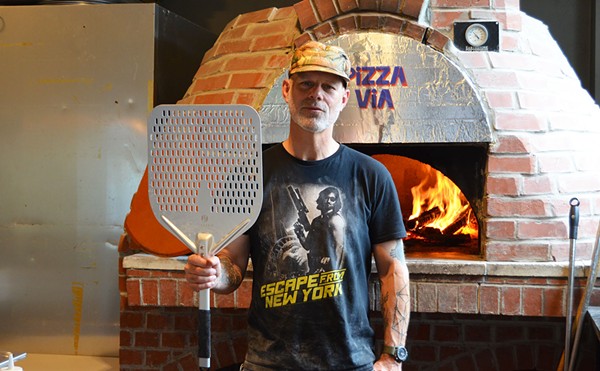Bluefin tuna is one of the fish on his list, which is a shame, because toro, the fatty meat from the bluefin's belly, makes some of the best sushi on earth. It's also an incredibly expensive way to eat sushi. Right now, bluefin is selling wholesale for about $22 a pound in Tokyo, and a piece of bluefin toro nigiri sushi can run you $10 in the United States. Even though I try to be environment-friendly, fresh bluefin toro tempts me mightily. Unfortunately, because we live in the middle of the country, there really isn't much chance of truly getting fresh sushi of any kind.
That's one of the problems with differentiating top-end sushi joints in the Midwest. In Japan, true connoisseurs won't eat sushi for dinner. They will only have it in the morning or for an early lunch, to make sure the fish is at its freshest. In St. Louis, unless you're into catfish sushi, there is a limit to how fresh you can get; the closest ocean is still pretty darn far away. Still, even with our geographic handicap, it's easy to tell the difference between terrific sushi restaurants and bait shops. There are standards for good sushi: properly prepared rice, good presentation and -- here's the key -- fish that is as fresh as possible. During my visits, Ichiban excelled at all three.
As with anything, context is important. The best sushi I've ever had was at a Las Vegas strip mall. At least some of that can be attributed to my spending the previous week rock-climbing in the desert, alternating between camp-stove-cooked ramen and macaroni and cheese. My meals at Ichiban came hard on the heels of a supermarket sushi binge and a disappointing experience at another St. Louis sushi joint.
After wiping my hands with a damp, steaming towel, I launched into an eating orgy, starting with toro. It wasn't bluefin toro, but toro from any tuna is better than no toro at all. It's a little steep at $4.25 for a single piece but worth the money for any sushi devotee. If you've never had it before, think of toro as the best piece of tuna you've ever had and then some. It's marbled and almost sad-looking -- the piece I received at Ichiban was somewhat tattered -- but in your mouth, toro is airy, delicate, creamy, fresh and clean. It's a hard act to follow.
Ichiban does an admirable job, however. My only real complaint with the sushi is that the chef needs to spread the wasabi on the nigiri sushi. Wasabi, which is essentially the Japanese version of horseradish, is traditionally swiped across the bottom of each piece of fish before it is placed on an oval of rice that is mixed with a light mixture of vinegar and sugar. Instead of a smear of wasabi, the chef gave each piece a dab. And the all-important difference between a smear and a dab is the difference between a pleasant flavor permeating an entire piece and a sudden burst of heat that makes your nose run. Still, that didn't stop me from eating my toro and then mowing through tuna, salmon, yellowtail, shrimp, halibut, scallop, squid, crab, red snapper, surf clam, octopus and freshwater-eel nigiri sushi.
The maki -- bite-sized pieces of sushi with a filling rolled in rice and wrapped with seaweed -- ranges from serviceable to excellent. The tuna, cucumber and California rolls are all serviceable. That's not an insult: There just isn't that much you can do to make that type of maki exciting. The spider rolls, on the other hand, kick butt. The crab was still hot when it hit the table, and each luscious roll was a joy to eat. The chirashi, assorted sliced fish on rice, is an adventure with every bite. It's a challenge to match rice to tuna to octopus to shrimp to cucumber to who-knows-what as the dish dissolves into a riot of raw fish.
For people looking for a Japanese meal that is totally cooked, Ichiban is still a winner. Even "safe" dishes, such as tempura and teriyaki, which I usually find boring, are worth ordering. Vegetable tempura, battered and fried broccoli, carrot, asparagus, zucchini, and onion, come out hot and avoid the greasy feel that many restaurants' offerings fall prey to. The chicken teriyaki is soupy in sauce and served over vegetables, but it's only a small part of the dish. Partitions make the teriyaki a party on a plate. The chicken is accompanied by a large mound of rice flecked with black sesame seeds, a mixed salad, shredded pickled vegetables, two pieces of California-roll maki and a carved-out orange filled with orange chunks and a strawberry.
The appetizers sparkle, with one exception: The negi maki -- scallion and beef, rolled and grilled -- is a little tough, and the scallions are too strong. The rest of the appetizers are superb, however. The shumai are substantial, despite their small size. Each dumpling is like a stack of half-a-dozen quarters. The wrapper covers lumps of crab, and somehow the shumai begin to taste even better as they cool. Hamachi kama, grilled yellowtail "chin," is tender, grilled and salted, with a seared crust over flaky flesh. Gyoza, fried dumplings, don't last long on the table.
The restaurant itself, a small space, was fairly busy both times I went. The decorations are a series of clichés, from the embroidered pillows on the booth benches to the fountain at the entrance to the seven-foot-tall bamboo stalks to the paper umbrellas in the rafters to the frosted individual windowpanes dividing the booths to the faux-bamboo floor. The amazing thing is, it works. Ichiban uses all of these clichés to create an individual feel. It is comforting yet elegant.
Sure, a few things didn't quite jibe: There was a muted television over the sushi-bar area, and the service, though extremely friendly, was off, with appetizers arriving after entrées in some instances. But that's nitpicking: Ichiban isn't perfect, but it is a restaurant I would recommend to anyone.





